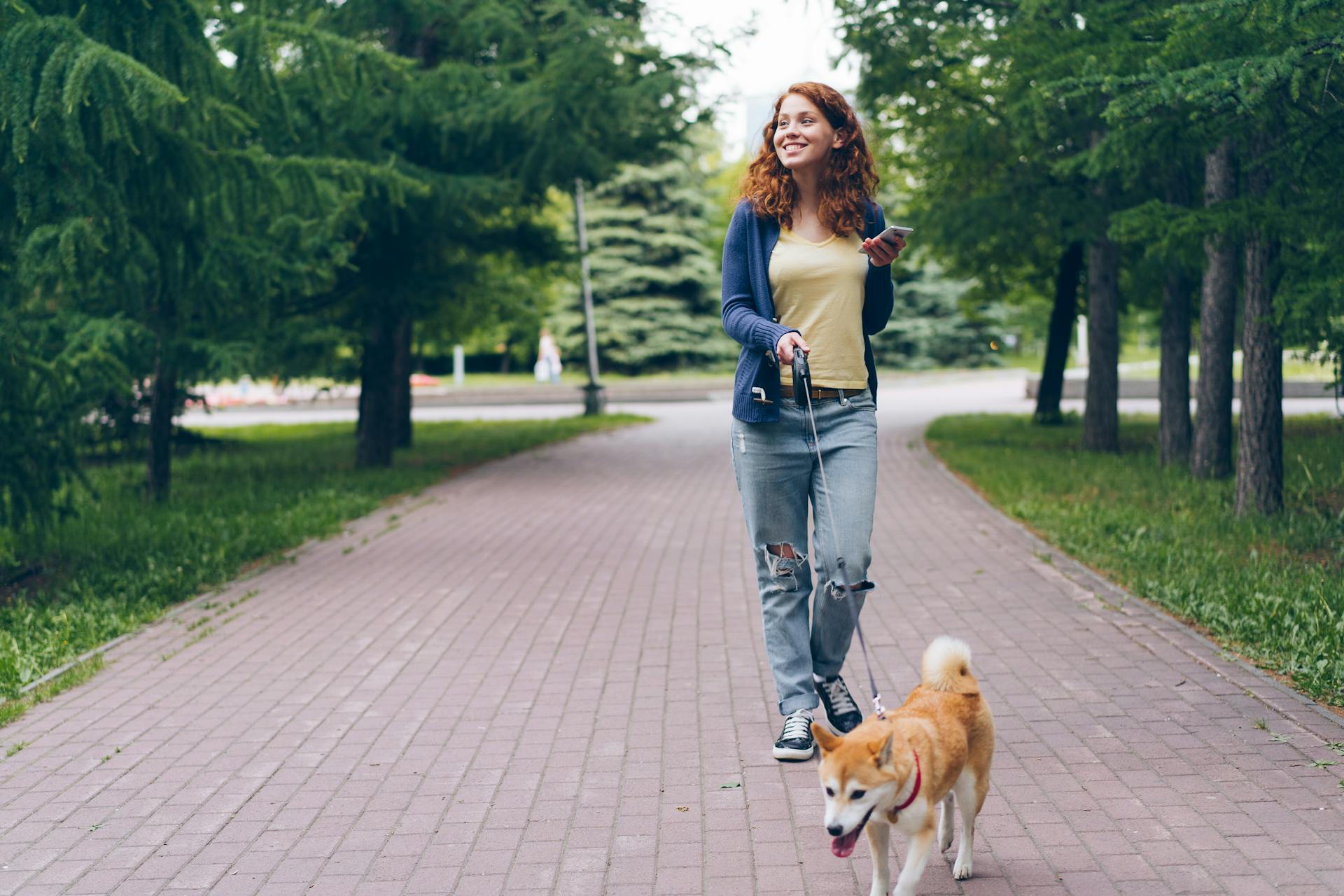
Dog potty training regression can be frustrating and confusing for both dogs and their owners. It's a common issue that can happen to any dog, regardless of age, breed, or training level.
One of the main reasons for dog potty training regression is a change in routine, which can cause stress and anxiety in dogs. This stress can lead to accidents in the house.
To prevent dog potty training regression, it's essential to establish a consistent routine and stick to it. This includes regular feeding times, exercise, and potty breaks.
Consistency is key, so try to maintain the same schedule even on weekends or during vacations.
Check this out: It's Your Choice Dog Training
Causes of Regression
Dogs tend to do best when their lives are fairly predictable or at least somewhat structured.
Stress is a common cause of house-training regression, often resulting from changes in a dog's life such as a housemate moving out or a new baby or pet moving in.
Some dogs react to a disrupted routine by relieving themselves indoors.
Anxiety can also trigger house-training regression, with common sources including separation from their people and loud, unpredictable noises.
Dogs may experience anxiety when their human companions undergo a major change, like a developing a medical issue or experiencing emotional trauma.
A dog's comfort and well-being can affect their ability to follow potty training, so it's essential to consider their physical and emotional state.
If your dog is not feeling well or is uncomfortable, they may forget their training and need extra attention and patience to relearn.
You might like: Conditioned Emotional Response Dog Training
Understanding Regression
Puppies typically experience a potty training regression around 6 to 8 months old, but it can occur as early as 3 months or as late as 12 months.
Many factors can contribute to potty training regression, including environmental changes, health-related issues, and even teething.
Some dogs may regress due to psychological factors, such as changes in family dynamics, while others may experience physical issues like illness or injury.
It's essential to recognize the signs of potty training regression early on and address the underlying causes to prevent further setbacks.
Dogs can experience a potty training regression at any age, not just during the initial training phase.
House-training regression is a common issue for young dogs between the ages of 4 months and 1 year, often due to scrambled connections in their brain.
It's not uncommon for dogs to experience potty training regressions, and with patience and perseverance, you can help your dog relearn what they have forgotten.
If your dog is experiencing a potty training regression, go back to basics and remind them of the commands and steps they need to follow.
Establishing a Routine
Dogs thrive on routine, and establishing a predictable schedule is crucial for successful house training. This includes scheduled feeding times, regular potty breaks, and exercise and playtime.
Consistent feeding times lead to predictable bathroom habits, so monitoring and adjusting your dog's diet can be beneficial if dietary issues are contributing to the regression. Regular potty breaks are also essential, with frequent, scheduled trips outside being necessary.
Here are some key elements to include in your dog's routine:
- Scheduled Feeding Times
- Regular Potty Breaks (every 1-2 hours, after meals and naps)
- Exercise and Playtime (at least 30 minutes, twice a day)
By sticking to a routine, you can help your dog feel more secure and reduce the likelihood of accidents. As one expert notes, "Dogs are creatures of habit, and they thrive on routine."
Lack of Supervision
Supervising your dog is crucial when potty training them. If you're not there to help them remember what they're supposed to do, they may have an indoor accident.
Signs that your dog needs to go potty include sniffing around, circling, whining or whimpering, and excessive licking of genitals. These behaviors can be subtle, so it's essential to be vigilant.
To supervise your dog effectively, keep an eye on them at all times, especially when you first start training. You need to be able to see if they're making signs that they need to go potty.
Here are some common signs that your dog needs to go potty:
- Sniffing around
- Circling
- Whining or whimpering
- Excessive licking of genitals
If you see your dog having an accident, you can quickly take them outside to finish the process. This will help ensure that they learn where they're supposed to go and that they don't start reverting to their old potty training habits.
Having your dog on a leash that is attached nearby is a great way to supervise them while keeping them safe. This allows you to immediately see the signs and take them out.
Establishing a Routine
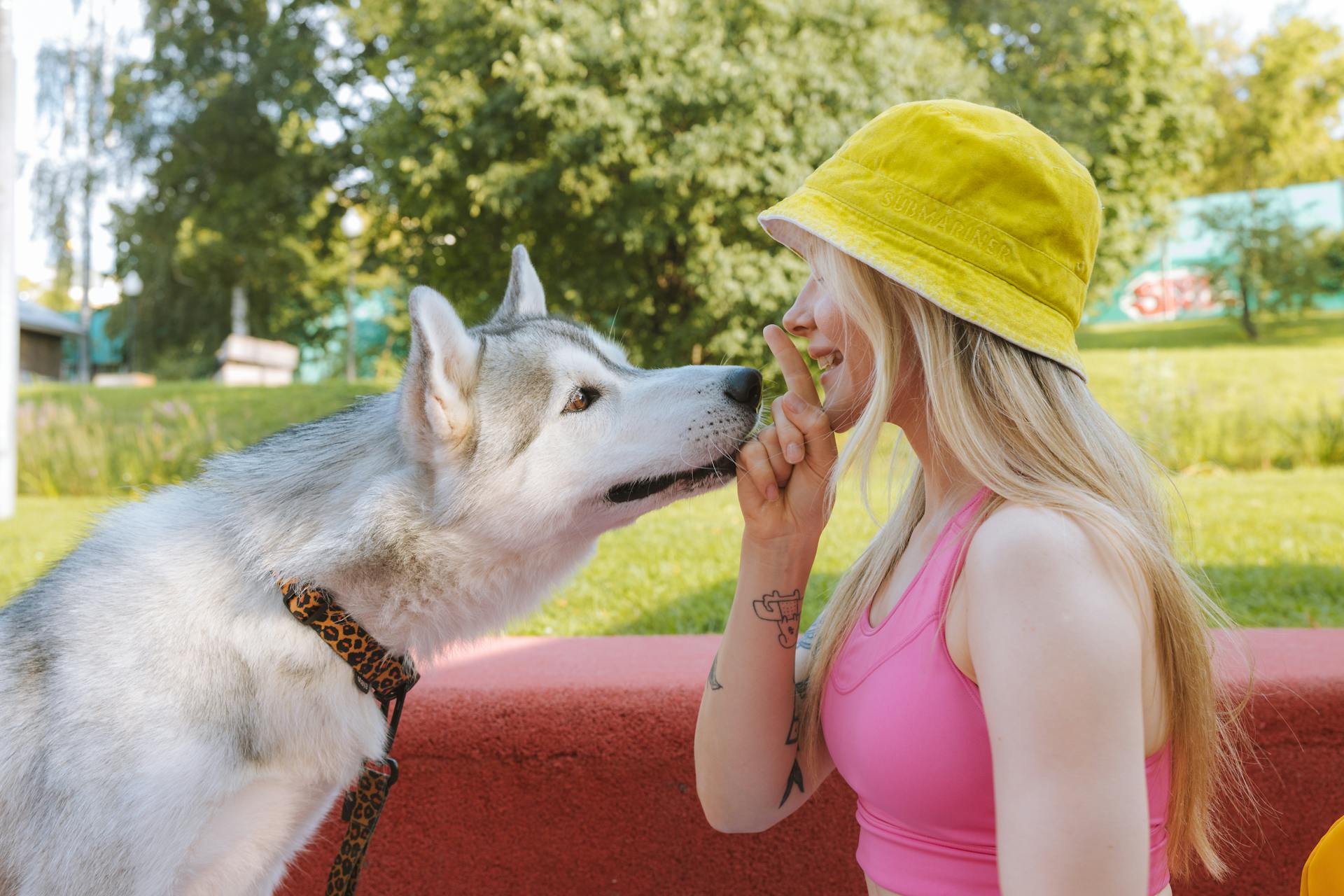
Establishing a routine is crucial for dogs, and it's not just about feeding times. Dogs thrive on predictability, and a consistent schedule can help prevent accidents. Scheduled feeding times lead to predictable bathroom habits, so it's essential to establish a routine that includes regular feeding times.
Consistent feeding times can also help monitor and adjust your dog's diet if dietary issues are causing regression. Regular potty breaks are also vital, especially after meals and naps. Pay attention to your dog's signals and take them out at regular intervals.
Here are some essential components of a routine:
- Scheduled Feeding Times
- Regular Potty Breaks
- Exercise and Playtime
These components can help regulate your dog's digestion and maintain a routine. If you're experiencing setbacks, remember that accidents are common with puppies up to a year old. Keep taking your puppy out at the first sign they need to go and offering rewards, and they'll learn.
Give Your Free Play Time
Free play time should be only a fraction of as long as your puppy can reasonably hold its bladder. So if your puppy can only last for an hour until the next potty break, let free play time be a maximum of 15 minutes.
Puppies have varying bladder capacities, so adjust free play time accordingly. If your pup can last four hours between potty breaks, let free play time be 50 or 60 minutes.
Dogs often signal that they need to relieve themselves by circling, sniffing at the ground, or whining.
You might enjoy: Last Resort for Dog Potty Training
Solutions and Strategies
Ruling out medical conditions is the first step in addressing potty training regression. If your dog is suddenly having accidents, it's possible there's an underlying health issue at play, so take them to the vet to rule that out first.
Consistency and positive reinforcement are key to overcoming regression. To help your dog feel more comfortable, provide a safe and quiet place for them to relax, and avoid loud noises or sudden changes in the environment.
Here are some strategies to consider:
- Provide regular exercise to help reduce stress
- Train your dog with positive reinforcement
- Decrease the time between breaks for a while
- Take regular bathroom breaks on a schedule
In some cases, working with a professional can be beneficial. A behaviorist or trainer can help you identify the root of the problem and come up with a plan to address it.
Stress or Anxiety
Stress or anxiety can be a major contributor to potty training regressions in dogs. If your dog is stressed or anxious about something, it can lead to accidents.
Thunderstorms and fireworks are common triggers for stress and anxiety in dogs. Loud noises can be overwhelming and cause your dog to feel anxious.
Discover more: Social Anxiety Dog Training
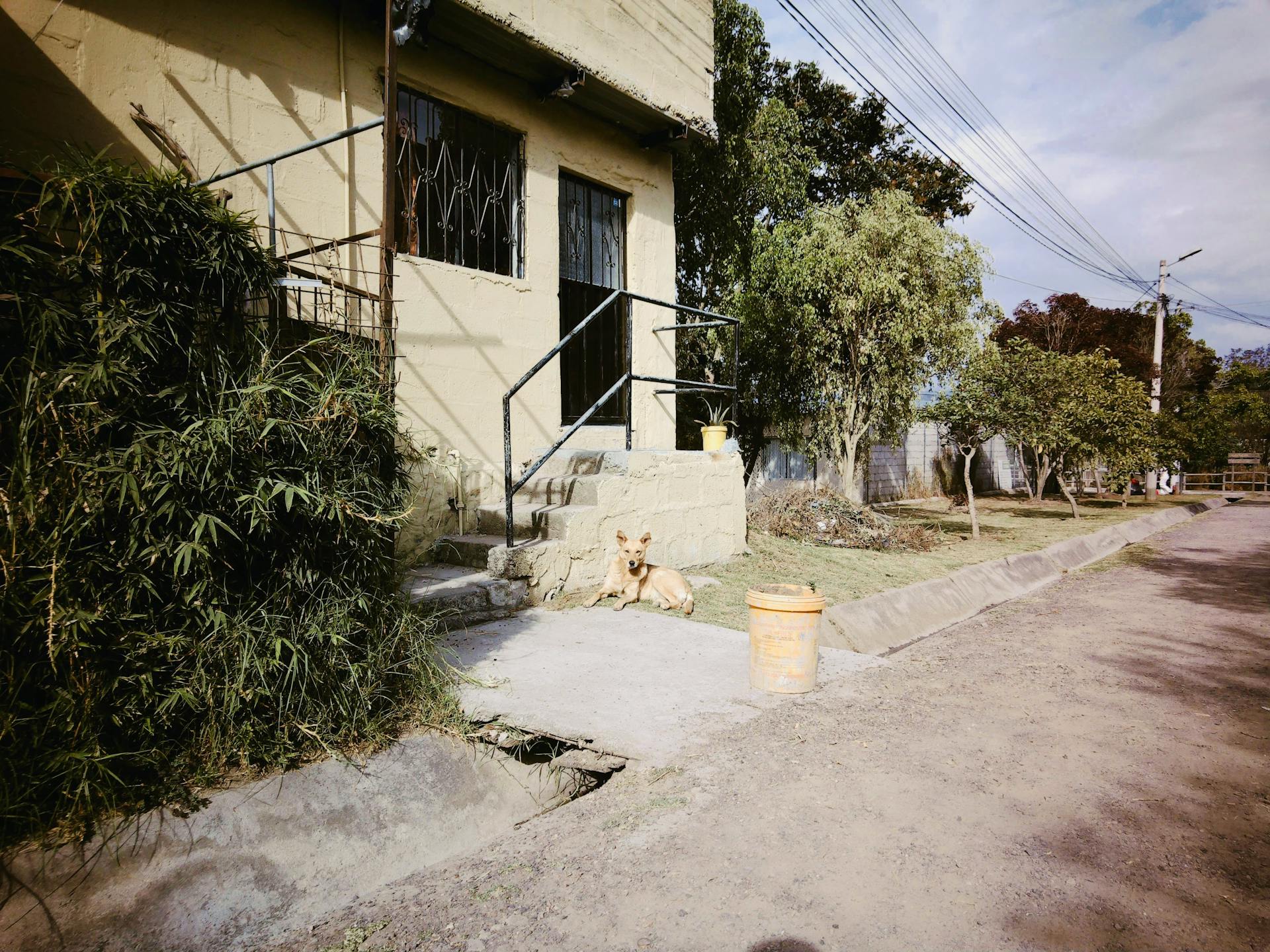
Separation anxiety is another common issue that can cause stress and anxiety in dogs. This can be especially true if your dog is left alone for long periods of time.
Changes in routine can also cause stress and anxiety in dogs. This can include changes in your work schedule, moving to a new home, or having a new baby in the house.
To help your dog feel more comfortable, provide a safe and quiet place for them to relax. Avoid leaving them alone for long periods of time and try to maintain a consistent routine.
Regular exercise can also help reduce stress and anxiety in dogs. This can include short walks or playtime in the yard.
Here are some common reasons that can cause stress and anxiety in dogs:
- Separation anxiety
- Fear of loud noises (thunderstorms, fireworks)
- Fear of people or other animals
- Anxiety caused by changes in routine
- Reacting to changes in their environment (new baby in the house, move to a new home)
- Changes in potty routine
Key Strategies to Overcome
Overcoming potty training regression in dogs requires a multifaceted approach that encompasses consistency, understanding, and patience. Each strategy plays a vital role in guiding your dog back to reliable potty habits.

To rule out any medical conditions that could cause regression, take your dog to the vet. If your dog is regressing because of stress or anxiety, try adding an extra potty break into their routine, giving them a special toy or treat during potty time.
Consistency is key. Be consistent in taking your dog to the same potty spot each time, and use a consistent command or cue word, such as "go potty!" or "do your business!" to help your dog associate the action with the command.
Positive reinforcement is a powerful tool in any training regimen. Immediately reward your dog with treats, praise, or play after they've successfully gone to the bathroom outside to reinforce the desired behavior.
Here are some key strategies to keep in mind:
- Rule out any medical conditions that could cause regression.
- Try adding an extra potty break into your dog's routine.
- Use a consistent command or cue word.
- Provide a safe and quiet place for your dog to relax.
- Regular exercise to help reduce stress.
Remember, overcoming potty training regression takes time, patience, and consistency. With a clear understanding of the strategies and techniques outlined above, you can help your dog overcome regression and achieve reliable potty habits.
Maintaining Progress
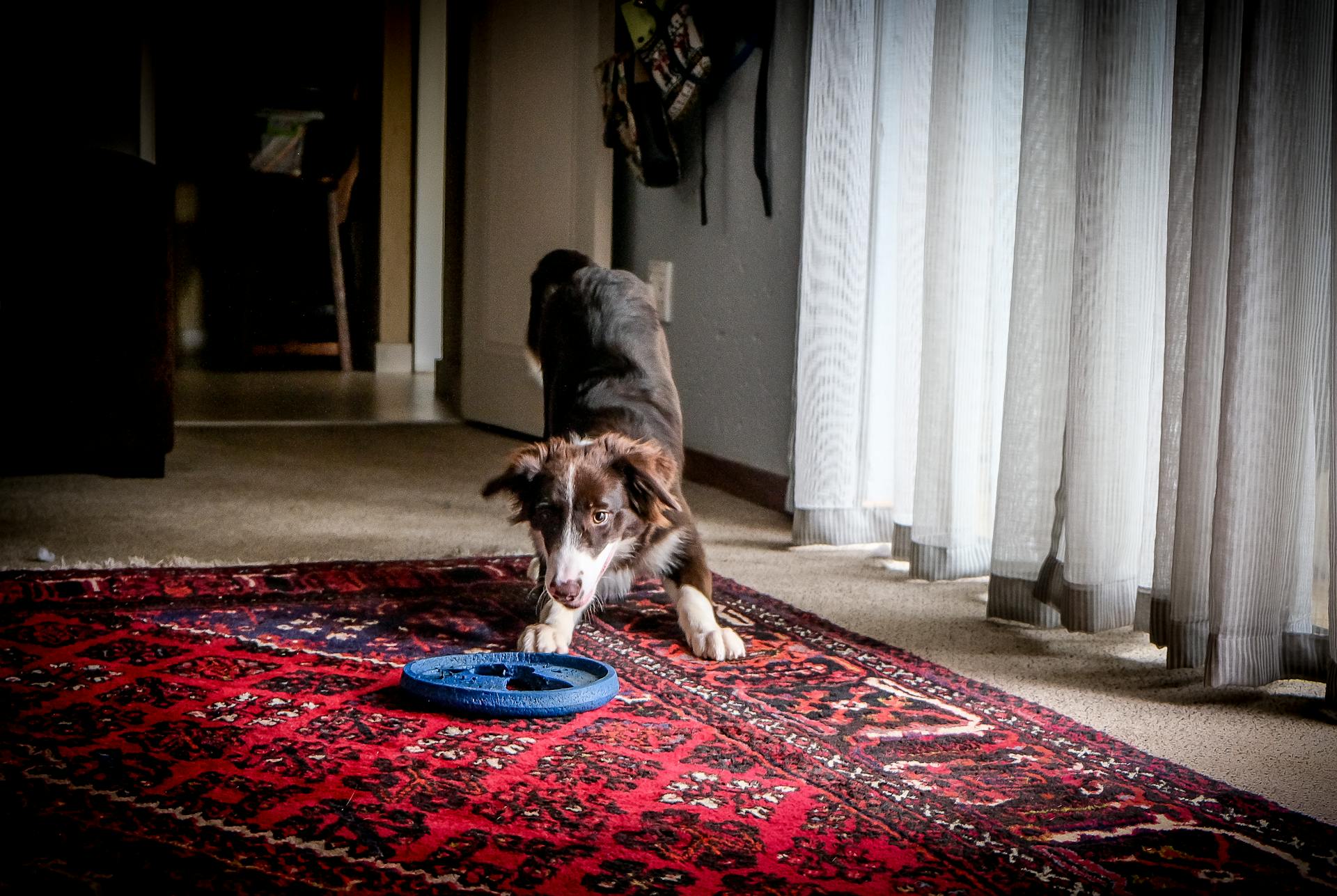
Maintaining Progress is crucial to prevent dog potty training regression. Regularly assessing and tweaking your routines can make a huge difference.
The goal is long-term success, and it's essential to stay consistent with your training methods. This means sticking to a schedule and not getting discouraged by setbacks.
Building a strong bond with your dog is vital, and they need to know you're in this together. This bond will help them trust you and respond better to training.
By regularly assessing and tweaking your routines, you can identify areas that need improvement and make adjustments accordingly.
Related reading: Begin the Bond Dog Training
Training and Etiquette
If you catch your puppy in the act, get their attention without scaring them so they know they have done something you don't like. You can clap or make another kind of noise, then take them outside by calling them or taking them gently by the collar.
Punishing your puppy for having an accident is not effective and can actually make things worse. Don't react angrily by yelling or rubbing their nose in it, as puppies and dogs aren't intellectually capable of connecting your anger with their accident.
To prevent accidents, consider staying outside longer with your puppy. They may need extra time to explore and stretch their legs before they feel the urge to go.
Expand your knowledge: Training Dog to Pee outside
How to Train
House training an older dog can be easier than training a puppy, as they can hold their pee and poop for longer periods. You can get your older dog on a regular schedule by feeding them at regular times and picking up their dish 10-15 minutes after putting it down, even if it still has food in it. This will help get their digestive system on a regular schedule so you can anticipate when they'll need to go.
Take your dog on a leash and go outside with them when it's time to go potty, even if you have a fenced-in yard. This way, you have a chance to praise and reward them right away when they go in their potty spot. It's a good idea to take your dog out first thing in the morning, after breakfast, a few times throughout the day, after dinner, and right before bed.
For your interest: Dog Training for Older Dogs
If your dog doesn't do their business, bring them back inside and put them in their crate or a room behind a baby gate, or keep them leashed and close to you. Over the next 10 minutes or so, watch for signs that your dog needs to go. When you see any, take them where you want them to go. Keep doing this until they do their business.
To minimize accidents, remember that dogs repeat behaviors that have rewarded them in the past, and they develop routines just like people do. Your job is to make pottying in the right place more rewarding to your dog than pottying in undesirable locations.
Accidents are common with puppies up to a year old, and the reasons for accidents range from incomplete house training to a change in the puppy's environment. Keep on training, even if your puppy has an accident, and take them out at the first sign they need to go.
Suggestion: Training Dog to Ring Bell to Go Out
House Etiquette
House Etiquette is all about creating a harmonious living space for both you and your furry friend. Keep an eye on your dog at all times when you first start training, so you can catch them making signs they need to go potty and take them out right away.
Punishing your puppy for having an accident is not an effective way to house train them. If your dog has had an accident in the house, it's already too late to correct their behavior, so stay calm and move forward.
If you catch your puppy in the act, get their attention without scaring them, and take them outside to finish going in the right spot. Praise and reward them when they're done, as this positive reinforcement will help them learn faster.
Don't react angrily to accidents, as puppies and dogs can't connect your anger with their behavior. Instead, clean up the mess with an enzyme cleaner to minimize odors that might attract your puppy back to the same spot.
You might like: When to Start Training a Dog
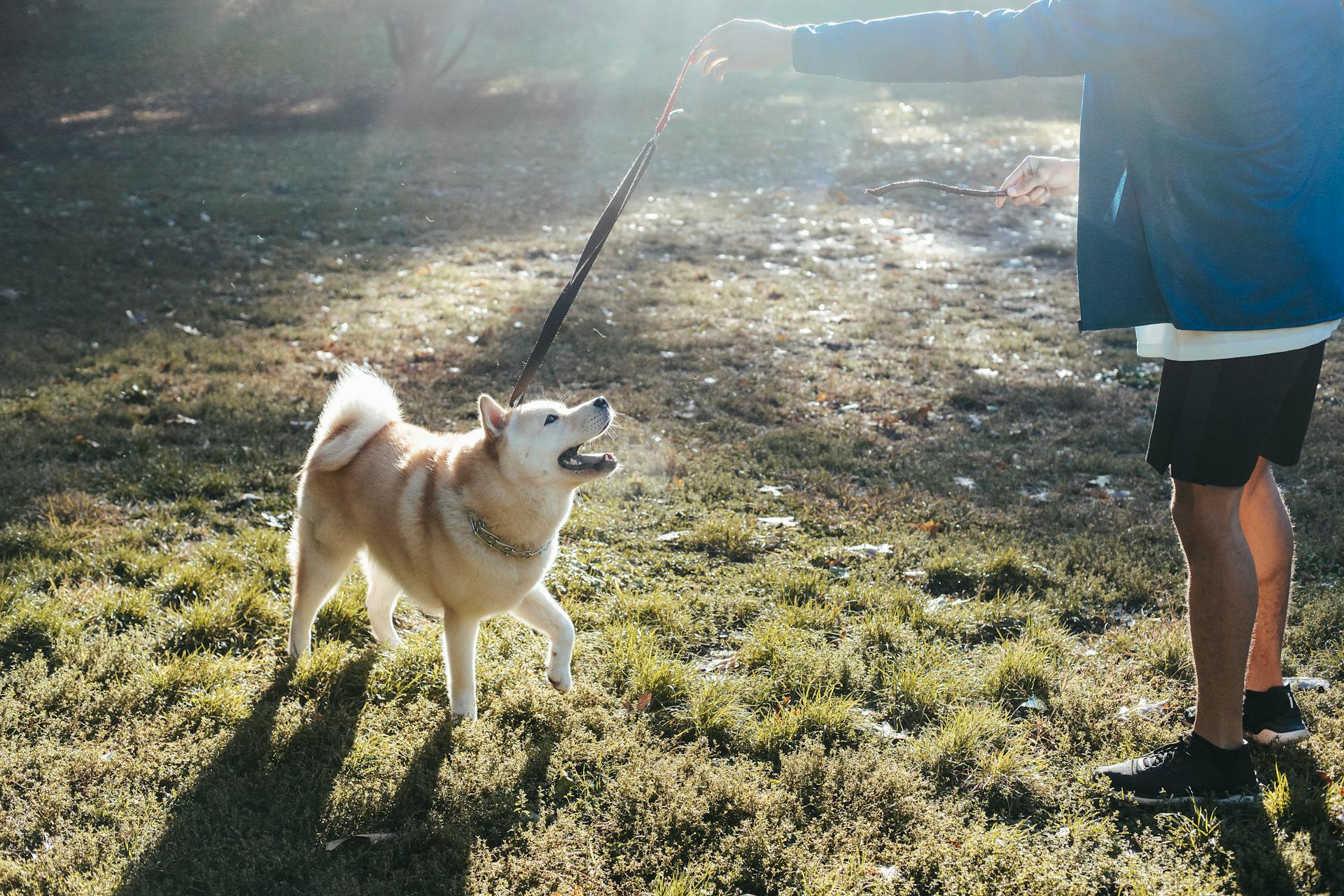
Here are some additional tips to help with house training:
Remember, house-training regression is a common issue for young dogs between 4 months and 1 year old. If your dog was house-trained and has since regressed, stay calm and don't worry – it's not a reflection on your training methods or your dog.
Featured Images: pexels.com


